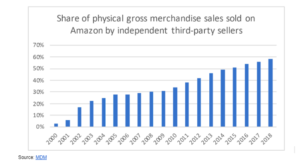A big question in the investor community and on Wall Street relates to Amazon’s future. Has Amazon’s marketplace business plateaued? This central question is the frame of reference (and arguably, the catalyst) for the introduction of the Buy with Prime program in the fall of 2022.
With the continued emphasis on Buy with Prime, it’s becoming apparent that Amazon wants to share (if not infuse) some of its eCommerce DNA with smaller and medium-sized brands. By opening access and creating products out of what were formerly discrete business units (advertising) and services (fulfillment, payments) – such as we’re seeing with Buy with Prime – we believe there is a HUGE opportunity. By using the best parts of Amazon not called “the marketplace” these emerging online businesses have the power to automate full-funnel advertising tactics and world-class logistics – and focus on building a brand through product development and customer service.
apparent that Amazon wants to share (if not infuse) some of its eCommerce DNA with smaller and medium-sized brands. By opening access and creating products out of what were formerly discrete business units (advertising) and services (fulfillment, payments) – such as we’re seeing with Buy with Prime – we believe there is a HUGE opportunity. By using the best parts of Amazon not called “the marketplace” these emerging online businesses have the power to automate full-funnel advertising tactics and world-class logistics – and focus on building a brand through product development and customer service.
In this post, we take a fifteen thousand-foot view of Buy with Prime’s potential future, how Amazon is using the program as a trojan horse, and what else we see in our ecommerce crystal ball.
The Evolution from Closed to Open
Amazon started out as an online bookstore that sold its products to consumers. Books by their nature were data-friendly in terms of building an online catalog and Bezos and team were able to quickly create Earth’s Biggest Bookstore.
building an online catalog and Bezos and team were able to quickly create Earth’s Biggest Bookstore.
In 2000, after some experimentation with online auctions and zShops, the Amazon marketplace launched with the goal of creating an endless aisle with a nearly infinite product selection. Amazon’s management team was clearly focused on “getting big fast” while understanding that access to more and more products and categories would play a vital role in both customer acquisition and customer retention. The combination of selling to consumers directly (1P or first-party via Vendor Central) and via the marketplace (3P or third-party via Seller Central) offered Amazon a clear path and even some friendly competition between its retail team and the seller community it was nurturing to grow listings and dramatically expand selection.

Trojan Horse, Shopify Hack, or My Little Pony?
 No secrets here, but Amazon has invested heavily. First in its logistics and warehouse network (aka “the moat”) and more recently in its advertising capabilities. The company is famous for solving internal problems first and then offering these same services to outside third parties to generate additional revenues. Think about Amazon Web Services or AWS – and how Amazon created it internally and oh by the way, essentially invented a new type of business based on selling cloud infrastructure. Amazon is in an enviable and unique position in that it can offer access to other businesses to leverage its logistics network and advertising solutions. Oh and the cherry on top? This also negatively impacts rivals such as Shopify and Google.
No secrets here, but Amazon has invested heavily. First in its logistics and warehouse network (aka “the moat”) and more recently in its advertising capabilities. The company is famous for solving internal problems first and then offering these same services to outside third parties to generate additional revenues. Think about Amazon Web Services or AWS – and how Amazon created it internally and oh by the way, essentially invented a new type of business based on selling cloud infrastructure. Amazon is in an enviable and unique position in that it can offer access to other businesses to leverage its logistics network and advertising solutions. Oh and the cherry on top? This also negatively impacts rivals such as Shopify and Google.
Q: What is the biggest challenge facing small to medium-sized e-commerce businesses?
A: Finding and retaining customers.
In 2021, Shopify opted to partner with Google and Meta to create a way for Shopify merchants to create and target lookalike audiences with ads on their platforms fueled by sales data from their stores.
In essence with this partnership, Shopify made the decision to stay out launching its own high-margin advertising service. Why? Not only would this help Shopify to generate more revenue (investors really like that, by the way) but it would also give them a full-funnel advertising play.
What do we mean by full funnel? Currently, Amazon is the only advertising solution that also owns transactional data (now almost three decades worth) that has been curated from customer product searches to customer purchases. This data in turn enables a compelling advertising engine for sellers and brands to efficiently and intuitively target Amazon’s most valuable customers, Prime members (now more than 200 million worldwide!).
advertising solution that also owns transactional data (now almost three decades worth) that has been curated from customer product searches to customer purchases. This data in turn enables a compelling advertising engine for sellers and brands to efficiently and intuitively target Amazon’s most valuable customers, Prime members (now more than 200 million worldwide!).
In contrast, Google’s business model has become almost entirely dependent on search advertising revenues. We won’t even mention the Department of Justice and its recent civil antitrust suit beyond this sentence. But clearly, any advertising competition from Amazon adversely impacts Google’s revenue long term.
It’s our position that Amazon’s Buy with Prime program will effectively siphon off advertising revenues from Google. It is also with noting that for Amazon advertising to succeed and truly become a Google “killer” Amazon will require significant scale from off-of-Amazon for the service to deliver consistent profits. And this is where we believe that Buy with Prime also hits the target and like with all other elements of Amazon, the goal is always to get the proverbial flywheel accelerating as quickly as possible.
New Business Model or What?
We see an opportunity for a new and leaner business model to emerge. Direct-to-consumer (DTC) brands can begin to dip their toes into Amazon’s waters by leveraging Buy with Prime instead of looking for third-party logistics (3PL) partners and instead of using that increasingly tired and traditional digital media (sorry Google).
The new business model is neither completely direct-to-customer nor is it marketplace-native but rather, the new approach relies upon leveraging parts of a very strong third-party (Amazon logistics and Amazon advertising) to grow and nurture a brand to success and profit.
The efficacy of this new business model is of course predicated on one thing. Money! 
Amazon must offer better pricing than 3PLs. Amazon must have better rates than incumbent freight carriers. And finally, they must make their advertising and marketing more efficient and affordable than other media solutions. If they can achieve this triple play in costs, efficiency, and effectiveness, watch out.
While incumbent and emerging DTC brands will continue to use software-as-a-solution (SaaS) platforms like Shopify, BigCommerce, etc. to build websites to sell their products to consumers, it’s the emergence of logistics-as-a-solution (LaaS) that has been unleashed via Buy with Prime that serves as the ultimate wake up call to 3PLs, freight carriers, and digital media incumbents.
So what does this all mean? While Buy with Prime is still new and in development, the jury is out! Buy with Prime if it is not nurtured, supported, and maintained by Amazon could lead to nothing. However, we believe the stakes are too massive for Amazon to “launch and leave” this program. Amazon’s been building and getting big fast for almost 30 years now, we feel confident that Buy with Prime is the future of Amazon and ecommerce in general. If you agree, disagree, or would like to debate any of this, please reach out to Equity Commerce today. We look forward to hearing from you.

